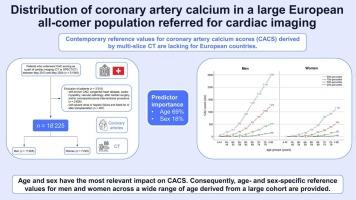Distribution of coronary artery calcium in a large European all-comer population referred for cardiac imaging
IF 2.5
Q2 CARDIAC & CARDIOVASCULAR SYSTEMS
引用次数: 0
Abstract
Background and aims
The coronary artery calcium score (CACS) is a well-established surrogate marker of atherosclerotic plaque burden and is highly valuable for risk stratification. However, contemporary data on the distribution of CACS across age and sex is lacking, particularly for European countries and quantified by multi-slice CT. We assessed predictors of CACS and provide granular age- and sex-specific reference values derived from a real-world clinical population referred for cardiac imaging.
Methods
This single-center, retrospective study examined patients clinically referred for non-invasive cardiac imaging from May 2013 to May 2024. Patients without coronary artery disease, cardiomyopathy, cardiac surgery or intervention, renal or hepatic failure were included. Multiple linear regression was used to identify independent predictors of CACS, and predictor importance was calculated. CACS percentiles were then calculated for both sexes and stratified across nine age groups.
Results
The final population consisted of 18′225 individuals (39.6 % women; 60.8 % symptomatic). Age and sex were the most influential predictors of CACS, accounting for 69 % and 18 % relative predictor importance, respectively. Men exhibited a significantly higher median CACS than women (59 [IQR 1–338] vs. 10 [IQR 0–129], p < 0.001) across all age groups.
Conclusions
This study provides contemporary age- and sex-based CAC score reference values, as observed in a large European real-world cohort referred for cardiac imaging. Age and sex exhibit the most relevant impact on expected CAC scores, while other conventional risk factors appear to be less important. Our results enable improved classification regarding the coronary calcium burden.

冠状动脉钙的分布在一个大的欧洲所有角落的人群参考心脏成像
背景和目的冠状动脉钙评分(CACS)是一种公认的动脉粥样硬化斑块负荷的替代指标,在危险分层中具有很高的价值。然而,关于CACS跨年龄和性别分布的当代数据缺乏,特别是在欧洲国家,并通过多层CT量化。我们评估了CACS的预测因素,并提供了来自真实世界临床人群的年龄和性别特异性参考值。方法本研究为单中心、回顾性研究,选取2013年5月至2024年5月间临床转诊的无创心脏影像学患者。没有冠状动脉疾病、心肌病、心脏手术或干预、肾脏或肝功能衰竭的患者被包括在内。采用多元线性回归识别CACS的独立预测因子,并计算预测因子重要性。然后计算男女的CACS百分位数,并在9个年龄组中分层。结果最终人群共18225例,其中女性39.6%,有症状者60.8%。年龄和性别是CACS最重要的预测因素,分别占69%和18%的相对预测重要性。在所有年龄组中,男性的中位CACS明显高于女性(59 [IQR 1-338]对10 [IQR 0-129], p < 0.001)。结论:本研究提供了当代基于年龄和性别的CAC评分参考值,这是在一个大型欧洲真实世界队列中观察到的。年龄和性别对预期CAC评分的影响最大,而其他传统的风险因素似乎不太重要。我们的结果使冠状动脉钙负荷的分类得到改进。
本文章由计算机程序翻译,如有差异,请以英文原文为准。
求助全文
约1分钟内获得全文
求助全文
来源期刊

IJC Heart and Vasculature
Medicine-Cardiology and Cardiovascular Medicine
CiteScore
4.90
自引率
10.30%
发文量
216
审稿时长
56 days
期刊介绍:
IJC Heart & Vasculature is an online-only, open-access journal dedicated to publishing original articles and reviews (also Editorials and Letters to the Editor) which report on structural and functional cardiovascular pathology, with an emphasis on imaging and disease pathophysiology. Articles must be authentic, educational, clinically relevant, and original in their content and scientific approach. IJC Heart & Vasculature requires the highest standards of scientific integrity in order to promote reliable, reproducible and verifiable research findings. All authors are advised to consult the Principles of Ethical Publishing in the International Journal of Cardiology before submitting a manuscript. Submission of a manuscript to this journal gives the publisher the right to publish that paper if it is accepted. Manuscripts may be edited to improve clarity and expression.
 求助内容:
求助内容: 应助结果提醒方式:
应助结果提醒方式:


